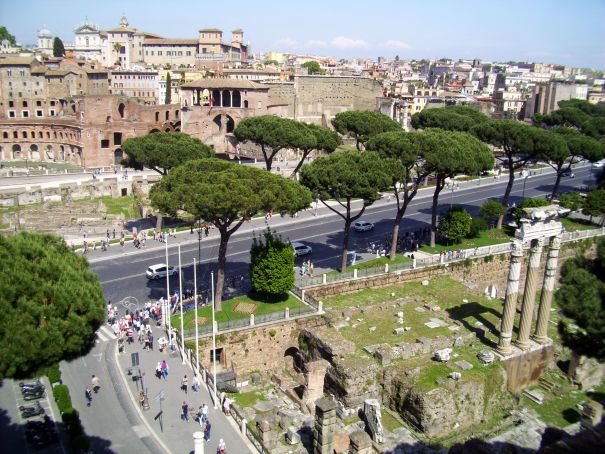A history of Rome's trees, from primeval oaks to the toppling pines of today.
Italo Calvino wrote fancifully how once upon a time “A monkey could leave Rome and, swinging from tree to tree, reach Spain without touching the ground.”
Rome’s sylvan nature rustles in the names of its hills, streets and squares. One etymology derives Esquilino from “aesculus” or “eschi”, a sort of oak that grew there; Viminale stems from “vimini”, the shoots of this former marshland’s willows, the Celio from “quercuetalanus” or “querce”, another oak. Piazza del Popolo evokes the poplar topping the place where Nero was buried, in the Domitii Ahenobarbi mausoleum which was on the Pincio. According to legend devils and witches danced around it, at least until the tree was felled and a chapel, now the famous church of S. Maria del Popolo, built in its place under Pope Paschal II in 1099.
Trees in mythology
More etymological thickets surround the name Rome itself, leading to “Ficus Ruminalis”, the fig-tree under which Romulus and Remus were nurtured, and sacred to the Etruscan goddess of breast-feeding. From earliest times a commemorative tree was a feature in the Roman Forum, the health of its branches portending the city’s fortunes.
Sacred groves
Rome’s hills each had their own sacred grove and protective priest; cutting down trees carried a possible death sentence. With the gradual destruction of the aqueducts after the fall of the empire, Rome’s horti dried up. Greenery remained scarce up to the 18th century when Grand Tourists lamented the dustiness of the city’s streets, the treeless corsi instead of verdant avenues.
Palm trees
Rome’s most characteristic trees are not originally Roman. Palms are said to have sprung from Julius Caesar’s weakness for dates and thanks to Titus’s legions returning victorious from Judea. As can be proved by a visit to the new S. Giovanni Metro C station, peach-trees appeared after Septimius Severus’s conquest of Persia in the third century AD. “ARRIVANO LE PESCHE”, declares a stretch of station wall. Behold, a glass case displays ancient peach-stones, unearthed 14 metres undergound by archaeologists during the station’s construction.
Following the time-line down the escalator to the level beneath, one discovers that millennia before the Neanderthals, and Rome not even a speck on the horizon, truly native trees were, together with the fore-mentioned oaks, the mountain ash, hornbeams, limes and various evergreens.
Cypresses
The cypress tree has always had a central role in the design of the most important Persian gardens but became associated with death because it was used in cremations as its strong fragrance kept corpse-stench at bay. It was also used to drape statues to Pluto, king of the underworld, and became a central theme in many Greek and Roman myths.
A notable specimen was supposedly planted by Michelangelo. Guarded by a set of colossal heads from Trajan’s forum, it is the centre-piece of Diocletian’s baths turned Carthusian cloister.
Umbrella pines
Which brings us to the city’s “arbostar” – “pinus pinea” or more commonly known as the umbrella pines – as celebrated in Resphigi’s symphonic poem Pines of Rome, when the shouts of children playing in Villa Borghese or by moonlight on the Gianicolo compete with the nightingale prerecorded in the American Academy’s courtyard, or with fanfares of triumphant legions marching back along Appia Antica.
The pines of Rome – or their distant forebears – were brought to Italy by Greek immigrants. According to Plutarch, the tree was sacred first to fertility goddess, Cybele, then to Neptune. As Claude Lorraine and Impressionist paintings bear witness, the trees favour coastlines. Finally they were sacred to Dionysius, their resin flavouring wine, as in today’s retsina. Livy relates the trees’ role in ship-building, “pinea” becoming an alternative word for ship. Meanwhile, their seeds – “pignoli” – are a staple of Roman cuisine, modern and ancient.

Due to their sheer good looks, however the trees’ main use is decorative. Search “Roman pine” online and there are more photos than for a Hollywood diva. “The ash is fairest of the wood, in gardens the pine,” states Virgil’s seventh Eclogue. In Fascist times, prompted by Resphigi’s final march movement, the authorities saw pines as a symbol of “Italianità”.
At Christmas 1937, Mussolini planted one in Piazza Venezia, the first in a row of 2,000 stretching from the Forum to what is now the the southern EUR suburb, centre of what should have been Italy’s showpiece 1942 Esposizione Universale di Roma. The trees would eventually line Via Imperiale (now Cristoforo Colombo) all the way to the sea at Ostia.
Lifespan
Planners in the 1930s also overlooked the fact that, in an urban setting, pines’ natural 180-year lifespan is halved. Leading to the recent spate of headlines: “SOS Pini”, “Tree Hits cab / supermarket / rail tracks” or “Montesacro: Fear At Dawn”. Nor is it just a matter of trees toppling. Their roots, undermining the asphalt, caused a young motorcyclist’s death in early May on Via Ostiense. Some 82,000 trees in Rome are monitored by the city's gardens authority. Yet as its director Rosalba Matassa explained in an interview with Italian daily La Repubblica, monitoring can only be conducted above ground. No instrument can control the roots. Pruning, another remedy, can be counterproductive as it make the trees grow taller, causing some to become top-heavy.
Also hard-pressed are Rome’s palm-trees, the red – though actually more orange-coloured – weevil, having arrived from North Africa via Sicily to afflict the palms of Rome. It is thought that as many as 30 per cent of those in Lazio may have been infected. The disease is difficult to identify until the top branches begin to droop and die. By then it is almost too late to cure the trees, although extensive early and then annual spraying has saved many around the city, especially in the Orto Botanico between Trastevere and the Janiculum.
Planes
Another species making headlines for the wrong reasons is the plane tree. “Rome’s Trees Strike Back”, this time for a plane tree crushing a bus, injuring its driver on Viale delle Milizie in the Prati district. About 15,000 planes, like the equally dense-leafed lime, reduce decibels by up to 30 per cent. They also lower temperatures and absorb ever-rising rates of pollution. Levels of lead in leaves near traffic have been found to be 20-80 times higher than in their rural counterparts. Introduced after the unification of Italy in 1871, planes were the Savoy dynasty’s species of choice, Viale Trastevere and other thouroughfares emulating any Parisian boulevard. Sickly yellow trunks and flaking bark – vegetal eczma – seem to be the price paid for combating whatever Rome’s inexorable traffic (and bus-stop smokers) can dump on them. Eco-barriers. Eco-warriors, heroes even. (One 15 metre-tall tree absorbs up to 10 kg of CO2 an hour.)

Other species are lambasted for growing where they shouldn’t, most notably ailanthus, brought from China by Jesuits in the 18th century. Despite its other name, Tree of Paradise, one recent article in La Repubblica accused it of undermining the Aurelian wall, comparing it and its innumerable seeds to a time-bomb. The author then cites its English name “Stink tree”, Neapolitan “cazzipicchio” and Genoese’s “albero di merda”. Rub its pointy leaves in your hand and the smell is acrid and long-lasting. With a prodigious root system, the infectious species is not difficult to find, engulfing railway embankments and motorways. In Via del Pigneto the trees compete for space, in one stretch outnumbering pines a dozen times over.
Magnolias
As an antidote, enter an indigene of the American South, magnolia grandiflora. Byword for fragrance, between Hard Rock Café and Hotel Excelsior they adorn Via Veneto’s upper reaches, flower-buds readying for June. Only don’t sleep under them: rural myth warns that their scent is so strong it might prove fatal.
Orange garden
More pristinely fragrant perhaps are the Aventino’s orange trees, all from a seed brought in 1220 by St Dominic from his native Spain. Or one could climb Salita del Grillo (up from Trajan’s forum) to the Angelicum University. In a quiet courtyard close to the students' entrance, an impressive olive-tree becomes even more so on noticing, as you gaze upward, some unlikely fig-leaves sprouting from its familiar gnarled trunk. It is one of Rome’s lesser-known wonders, olive tree and fig tree in one.
By Martin Bennett
This article was published in the September 2018 edition of Wanted in Rome magazine.


















